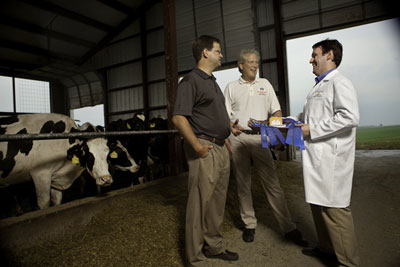
The Center for Dairy Research has played an important role in Wisconsin's artisan cheese industry. John Lucey, right, director of the Center for Dairy Research (CDR), shares a few of the state's award-winning artisan cheeses with John Umhoefer, left, and Mark Schleitwiler from the Wisconsin Cheese Makers Association.
In 1951, milk was delivered in cans; Wisconsin cheese makers produced mostly cheddar and Babcock Hall was built at the University of Wisconsin-Madison.
Sixty years later, milk arrives by semi-trailer; Wisconsin cheese makers produce hundreds of varieties of cheese, and what happens in Babcock Hall and the Center for Dairy Research (CDR) that’s housed there remains an essential catalyst for the state’s expanding artisan cheese industry.
“Every company in our industry has benefitted from Babcock Hall and the Center for Dairy Research,” said John Umhoefer, executive director of the Wisconsin Cheese Makers Association. “They are virtually a doctor on call for the cheese industry.”
The established partnership between CDR and the cheese makers enters a new phase as the association backs a $25 million campaign, with the expectation of $12.5 million in state support, to renovate Babcock’s dairy plant and CDR facilities with a $500,000 pledge. “For our industry, this is considered the opportunity of a generation,” Umhoefer said.
From a second-floor observation deck, visitors can watch the Babcock staff make ice cream and cheese. CDR researchers, whose efforts answer specific, practical questions from cheese makers, work out of sight, fitting into unused nooks and crannies.
“We have had a dairy school here for more than 100 years,” CDR Director John Lucey said. The center was established in 1986 to provide applied research, training and support for the dairy industry.
Most of Wisconsin’s cheese factories and dairy plants do not have research and development staff, so they turn to CDR, Lucey said. “What’s this?” “Why didn’t this perform?” “What do you think of this new ingredient? This new piece of equipment?” “Can you run a cheese trial on this product idea for me?”
When second- and third-generation cheese makers sign up for dairy courses, they learn what’s changed. “Our role is not to tell them, forget what you know, but to say, there are other possibilities – and we’ll show you how to do it as well as explain why,” Lucey said. With CDR’s help, Wisconsin cheese makers produce almost half of the specialty cheese made in the United States and won 60 percent of the 2011 U.S. Championship Cheese Contest awards in March.
“Agriculture in Wisconsin contributes more than 10 percent of total employment with most of this in rural communities and our focus is to maintain the long term strength of the dairy processing sector.”
John Lucey
As the dairy short course roster nears its 10,000th student since the CDR opened its doors, Lucey said the center is swamped with attendees. The renovation will bring air-handling equipment into the dairy plant that makes more summer courses possible and add enough room for 55 industry staff or students to gather around cheese vats for hands-on learning. The project also will create the special, environmentally controlled rooms needed to make many more cheeses, from blue to smear to goat cheese, as well as yogurts and other cultured products.
“The consumer wants more highly flavored artisan cheeses and cultured products like Greek yogurt,” Lucey said. “That’s what’s happening now in industry.”
The original building was built to make traditional varieties like Cheddar, Colby and Mozzarella, Lucey said. With no way to isolate it, cheeses that require molds present challenges. “If I contaminate the whole dairy plant with blue mold, I would not be the most popular person in the building.”
The major commodity cheese manufacturers largely moved west to California, Idaho, New Mexico and Texas, Umhoefer said. Wisconsin grew organically, from small farms and corner cheese factories to today’s small, medium and some large factories, some run by families who’ve been making cheese since the 1800s. “To survive they have learned to make hundreds of new varieties of cheese,” he said.
“We are not about making the cheapest cheese, but the best quality cheese, as is obvious from the many awards that our cheese makers win” Lucey added. “Agriculture in Wisconsin contributes more than 10 percent of total employment with most of this in rural communities and our focus is to maintain the long term strength of the dairy processing sector.”
Babcock Hall’s CDR and the Food Science Department have provided the brain trust for that transformation, Umhoefer said. “It’s one thing to make a cheese; it’s another thing to make it consistently. They’re about quality at the UW. They understand microflora, biology, chemistry and how to solve problems.”
With the anticipation of making sheep, goat milk and international cheeses, Umhoefer expected cheese makers to turn increasingly to CDR to learn how to make new varieties. “We’re just at the beginning of the trend,” he said. “There are so many cheeses to discover.”
